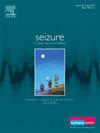Prevalence of and risk factors for sarcopenia in patients with epilepsy
IF 2.7
3区 医学
Q2 CLINICAL NEUROLOGY
引用次数: 0
Abstract
Background
Epilepsy is a chronic neurological disorder with a burden of comorbidities. Knowledge regarding sarcopenia prevalence and associated risk factors in patients with epilepsy remains limited, which prompted us to conduct the present study.
Methods
This cross-sectional study enrolled patients with epilepsy from our epilepsy clinic and controls from the staff at National Cheng Kung University Hospital, Tainan, Taiwan. Sarcopenia was defined using the criteria outlined by the 2019 Asian Working Group for Sarcopenia and the 2010 European Working Group on Sarcopenia in Older People. Muscle mass (skeletal muscle mass index) was measured through bioelectrical impedance, muscle strength was assessed using hand grip tests, and physical performance was evaluated using the 6-m walk test. Hormone (testosterone, growth hormone, and insulin-like growth factor-1) and vitamin D levels were measured. Descriptive statistics and logistic regression models were used to estimate the prevalence of sarcopenia and identify sarcopenia risk factors in patients with epilepsy.
Results
This study enrolled 300 adults (mean age: 42.9 ± 14.7 years; women: 53.7 %). The epilepsy and control groups comprised 200 and 100 participants, respectively. The overall prevalence of sarcopenia was 31.3 % and it was significantly higher (p = 0.004) in women (20.7 %) than in men (10.6 %). The prevalence was higher in the epilepsy group than in the control group (36.0 % vs. 22.0 %, p = 0.014). Logistic regression revealed female, age (≥ 65 year) and low body mass index (BMI) were influenced the risk of sarcopenia in all participants. Importantly, epilepsy is significantly associated sarcopenia. The BMI, protein level, calf circumference, and use of enzyme-inducing antiseizure medications (EIASM) influenced the risk of sarcopenia in the epilepsy group.
Conclusion
The prevalence of sarcopenia is significantly higher in patients with epilepsy than in the control participants. Low BMI, protein level, calf circumference, and the use of EIASM may increase the risk of sarcopenia in this population. Our findings underscore the need for mitigating sarcopenia risk in patients with epilepsy.
癫痫患者肌肉减少症的患病率及危险因素。
背景:癫痫是一种慢性神经系统疾病,具有并发症的负担。关于癫痫患者肌少症患病率和相关危险因素的知识仍然有限,这促使我们进行本研究。方法:本研究以台湾台南国立成功大学附属医院癫痫门诊的癫痫患者为研究对象。肌少症的定义使用2019年亚洲肌少症工作组和2010年欧洲老年人肌少症工作组概述的标准。通过生物电阻抗测量肌肉质量(骨骼肌质量指数),通过握力测试评估肌肉力量,通过6米步行测试评估身体表现。测量了激素(睾酮、生长激素和胰岛素样生长因子-1)和维生素D水平。采用描述性统计和logistic回归模型估计癫痫患者肌肉减少症的患病率,并确定肌肉减少症的危险因素。结果:本研究招募了300名成人(平均年龄:42.9±14.7岁;女性:53.7%)。癫痫组和对照组分别有200名和100名参与者。肌肉减少症的总体患病率为31.3%,女性(20.7%)显著高于男性(10.6%)(p = 0.004)。癫痫组患病率高于对照组(36.0%比22.0%,p = 0.014)。Logistic回归显示,女性、年龄(≥65岁)和低体重指数(BMI)是影响所有参与者肌肉减少症风险的因素。重要的是,癫痫与肌肉减少症显著相关。体重指数、蛋白质水平、小腿围和酶诱导抗癫痫药物(EIASM)的使用影响癫痫组肌少症的风险。结论:癫痫患者肌少症患病率明显高于对照组。低BMI、蛋白水平、小腿围和EIASM的使用可能会增加这一人群发生肌肉减少症的风险。我们的发现强调了减轻癫痫患者肌肉减少症风险的必要性。
本文章由计算机程序翻译,如有差异,请以英文原文为准。
求助全文
约1分钟内获得全文
求助全文
来源期刊

Seizure-European Journal of Epilepsy
医学-临床神经学
CiteScore
5.60
自引率
6.70%
发文量
231
审稿时长
34 days
期刊介绍:
Seizure - European Journal of Epilepsy is an international journal owned by Epilepsy Action (the largest member led epilepsy organisation in the UK). It provides a forum for papers on all topics related to epilepsy and seizure disorders.
 求助内容:
求助内容: 应助结果提醒方式:
应助结果提醒方式:


